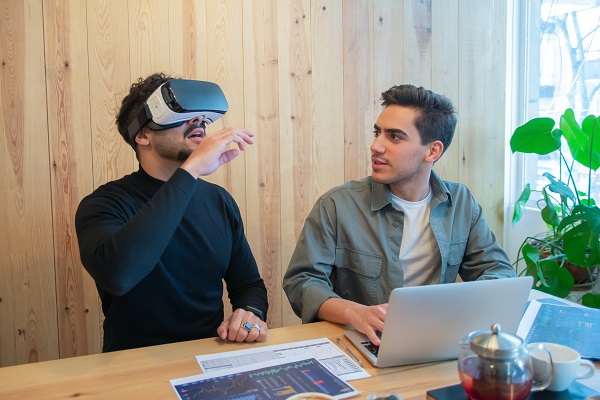Integrating immersive technologies in VET

Virtual and augmented realities
Immersive technologies integrate digital content with the physical environment which enables users to engage with a constructed reality.
- Virtual reality (VR) is a live digital environment that encompasses the user’s perception of their surroundings.
- Augmented reality (AR) is digital content that is superimposed over live images of the real environment.
The ET2020 working group on vocational education and training (VET) has released a report on innovation and digitalisation that looks at how innovation and digitalisation can support higher quality, more flexible and modern VET, along with ways of how VET systems can integrate them. It provides insights into the impact of innovation and digitalisation on VET and building the capacity of VET to support them.
Safer training in the construction sector
Immersive learning has the potential to transform VET, so students can train in safe, realistic conditions without risk by using immersive simulations of real-world work environments.
For example, the teacher-led project VRhoogte in Flanders has developed a VR training module for secondary VET students to learn how to work safely in high places (such as high-voltage pylons or wind turbines) in a virtual environment using Oculus Quest. Students use a VR module for skills training in a safe, interactive and challenging environment during their preparation for the workplace.
The fourth industrial revolution
Industry 4.0 is the digital transformation of the ways companies manufacture, improve and distribute their products using innovative technologies. This includes new perceptual models such as VR and AR, as well as cloud computing and analytics along with AI and machine learning.
Skilled workers are confronted with increasingly complex systems that can only be mastered through experience and training, but training has costs and risks; AR and VR can support VET in safely and economically preparing for Industry 4.0.
The Erasmus+ project Technology Industry 4 (TI4) for VET teachers and trainers developed innovative educational materials and tools for the study of Industry 4.0 technologies on an interactive e-learning platform. The results of the project provided insights into current and future global trends in advanced manufacturing, and improving cooperation between teachers, schools, students and employers.
3D modelling in real and virtual spaces
Immersive technologies can also work alongside other digital technologies and skills, such as CAD modelling and 3D printing.
Although 3D printing experts are among the most in-demand employees in the IT and manufacturing labour markets, training in the use of 3D printers and related skills is currently underrepresented in vocational education.
The Erasmus+ co-funded 3DVET project in Estonia, Hungary, Poland and Türkiye sought new methods, materials and technological developments to help VET educators guide their students to be future 3D printing specialists – including training in the use of augmented reality to design 3D-printed objects. It produced an all-in-one 3D training web platform that includes free downloads of software, tutorials and pedagogical materials.
The Erasmus+ co-funded 3D4VR project focused on integrating knowledge about CAD modelling, 3D printing and VR in the technical, vocational and medical education settings. Its goal was to transfer the innovative specialised skills and tools used in these technological settings to the VET sector through specialised education modules and gave special attention to designing suitable materials for people who are visually impaired or have other physical disabilities.
The project produced a prototype learning system, including a handbook of recipes for 3D experience improvement, an e-learning platform (and its first course on guidelines for creating 3D and VR experiences), all of which have been designed to be able to evolve rapidly as technologies and learning requirements change.
Additional information
-
Education type:Vocational Education and Training
-
Evidence:N/A
-
Funding source:European Commission
-
Intervention level:N/A
-
Intervention intensity:N/A
-
Participating countries:BelgiumCroatiaEstoniaHungaryPolandSlovakiaTurkey
-
Target audience:Careers CounsellorGovernment staff / policy makerHead Teacher / PrincipalStudent TeacherTeacherTeacher Educator
-
Target audience ISCED:Upper secondary education (ISCED 3)
